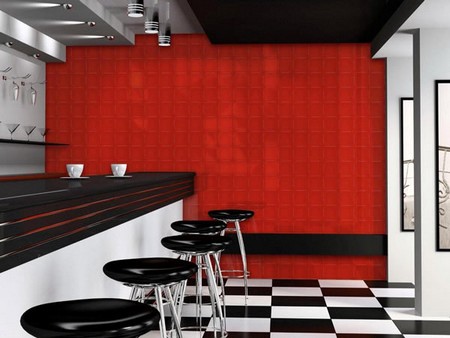As an alternative to using batten fixing for dry-lining a solid wall, tapered-edged plasterboard can be bonded directly to the wall with dabs of plaster or an adhesive. Special pads are produced for leveling up the wall, but squares cut from remnants of the plasterboard itself can be used. The pads are first bonded to the wall in lines that substitute for battens, then dabs of plaster are applied between the lines of pads and the plasterboard is temporarily nailed to the pads while the plaster sets. The special double-headed nails are then removed.
Boards 900mm (3ft) wide are usually used with this technique. The wall must first be prepared in the usual way.
Fixing the pads
Set out vertical chalk lines on the wall 450mm (I ft 6in) apart, working from one corner or from a doorway or window opening.

Draw a horizontal line 225mm (9in) from the ceiling, one 100mm (4in) from the floor and another centred between them. If the wall is more than 2.4m (8ft) high divide the space between the top and bottom equally with two lines. The pads are placed where the horizontal and vertical lines intersect.
Using a spirit level and a straightedge almost the height of the wall, check the wall at each vertical line, noting high spots at the intersections of the lines. Bond a pad on the most prominent intersection point, using a bonding-coat plaster or a proprietary plaster adhesive, and press it in place to leave not less than 3mm of adhesive behind it. All the rest of the pads are leveled up to this first one with plaster or adhesive.
Bond and plumb the other pads on the same vertical line, then complete a second vertical row two lines from the first. Check these pads for level vertically, then diagonally with the first row. Work across the wall in this way, then fix the remaining pads on the other intersections. Allow two hours to set.
Fixing the plasterboard
Apply thick dabs of adhesive or bonding plaster to the wall with a trowel over an area for one board at a time. Space them 75mm (3in) apart vertically and do not overlap the area of the next board. Press the board firmly against the pads so that the plaster spreads out behind it. Use the straightedge to press it evenly and the footlifter to position it.
Check the alignment, then fix the board with double-headed nails driven through it into the pads round the edge. Fix the next board in the same way, butting it to the first, and work on across the wall, scribing the last board into the internal angle. When the plaster has set remove the nails with pincers or a claw hammer, protecting the plasterboard surface.
Work round angles and openings and when all surfaces are covered fill and finish the joints.